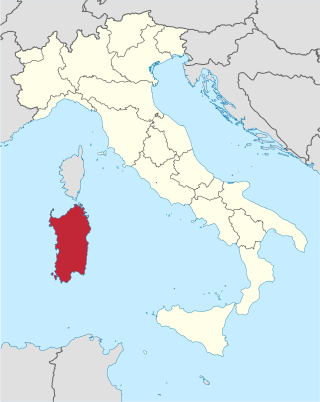
Sardinia is the second-largest island in the Mediterranean Sea, after Sicily, and one of the twenty regions of Italy. It is located west of the Italian Peninsula, north of Tunisia and immediately south of the French island of Corsica.
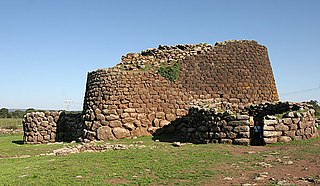
The nuraghe, or nurhag, is the main type of ancient megalithic edifice found in Sardinia, Italy, developed during the Nuragic Age between 1900 and 730 BC. Today it has come to be the symbol of Sardinia and its distinctive culture known as the Nuragic civilization. More than 7,000 nuraghes have been found, though archeologists believe that originally there were more than 10,000.

Olbia is a city and commune of 60,346 inhabitants in the Italian insular province of Sassari in northeastern Sardinia, Italy, in the historical region of Gallura. Called Olbia in the Roman age, Civita in the Middle Ages and the Terranova Pausania until the 1940s, Olbia has again been the official name of the city since the fascist period.
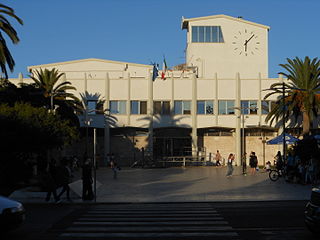
Porto Torres is a comune (municipality) and a city of the Province of Sassari in north-west of Sardinia, Italy. Founded during the 1st century BC as Colonia Iulia Turris Libisonis, it was the first Roman colony of the entire island. It is situated on the coast at about 25 kilometres (16 mi) east of Falcone Cape and in the center of the Gulf of Asinara. The port of Porto Torres is the second biggest seaport of the island, followed by the port of Olbia. The town is very close to the main city of Sassari, where the local university takes office.

Capoterra is a town and comune in the Metropolitan City of Cagliari, Sardinia, Italy. At 2011 national census it had 24,017 inhabitants and is part of the Cagliari metropolitan area.

Su Nuraxi is a nuragic archaeological site in Barumini, Sardinia, Italy. Su Nuraxi simply means "The Nuraghe" in Campidanese, the southern variant of the Sardinian language.
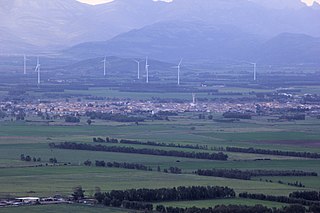
Pabillonis, Pabillonis in the Sardinian language, is a comune (municipality) in the Province of South Sardinia in the Italian region Sardinia, about 50 kilometres (31 mi) northwest of Cagliari and about 15 kilometres (9 mi) west of Sanluri.
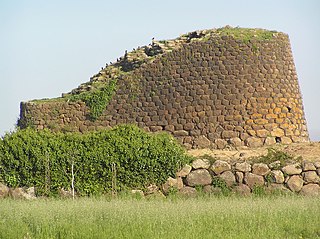
The nuraghe Losa is a complex prehistoric building in the shape of a tholos tomb. Its central structure has a triangular shape.

The Nuragic civilization, also known as the Nuragic culture, was a civilization or culture on the Mediterranean island of Sardinia, Italy, which lasted from the 18th century BC up to the Roman colonization in 238 BC. Others date the culture as lasting at least until the 2nd century AD and in some areas, namely the Barbagia, to the 6th century AD or possibly even to the 11th century AD.

Monte d'Accoddi is a Neolithic archaeological site in northern Sardinia, located in the territory of Sassari. The site consists of a massive raised stone platform thought to have been an altar. It was constructed by the Ozieri culture or earlier, with the oldest parts dated to around 4,000–3,650 BC.

Sardinia is the second largest island in the Mediterranean Sea and an autonomous region of Italy. Tourism in Sardinia is one of the fastest growing sectors of the regional economy. The island attracts more than a million tourists from both Italy, from the rest of Europe, and, to a lesser degree, from the rest of the world. According to statistics, tourist arrivals in 2016 were 2.9 million people.

The Giants of Mont'e Prama are ancient stone sculptures created by the Nuragic civilization of Sardinia, Italy. Fragmented into numerous pieces, they were discovered in March 1974 on farmland near Mont'e Prama, in the comune of Cabras, province of Oristano, in central-western Sardinia. The statues are carved in local sandstone and their height varies between 2 and 2.5 meters.

Santu Antine, also known as Sa domo de su re is a nuraghe in Torralba, one of the largest in Sardinia. It is located in the centre of the Cabu Abbas plain. The main structure was built around the 19-18th century BC, and the other parts of the nuraghe date back to the 17th–15th century BC. The main tower originally reached a height of 23–24 metres and contains three tholoi chambers on top of each other. The central tower with diameter of 15 metres is 17 metres high. Santu Antine is made of huge basalt blocks. It has three floors. The top floor is now gone. Some 27 meters long corridors built with the corbel arch technique can be observed inside of the Nuraghe, superimposed on two floors, the Nuraghe was provided with three wells.

The Nuraghe La Prisgiona is a nuragic archaeological site, located in the Capichera valley in the municipality of Arzachena Costa Smeralda in the north of Sardinia. It consists of a nuraghe and a village comprising around 90–100 buildings, spread across 5 hectares. Findings from this site are in many cases unique in Sardinia, particularly with regard to decoration and use. Due to the large extent and number of buildings the site is considered unique in North-East Sardinia. There is also some evidence for occupation during Roman and medieval times. The Giants' grave Coddu Vecchiu is located nearby.

The Sacred pit of Garlo is an archaeological site near the village of Garlo in Pernik District, Bulgaria.

The nuraghe Seruci is an important archaeological site, located in the municipality of Gonnesa, in the Iglesiente region of Sardinia.

The nuraghe Palmavera is an archaeological site located in the territory of Alghero, Sardinia. It is classified as a complex nuraghe, that consists of several towers joined together. The nuraghe and the surrounding village were built in various phase during the Bronze Age and the Iron Age.

The nuraghe Is Paras is an archeological site of Isili, a town in the historical region of Sarcidano, province of South Sardinia.

The Nuraghe Antigori is a nuragic complex dating back to the second millennium BC. It's located in the municipality of Sarroch, in the Metropolitan City of Cagliari.
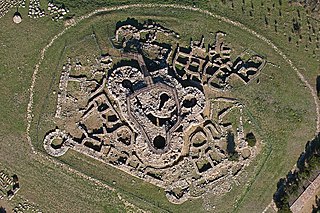
The nuraghe Genna Maria is an archaeological site in the comune of Villanovaforru, province of South Sardinia.






















